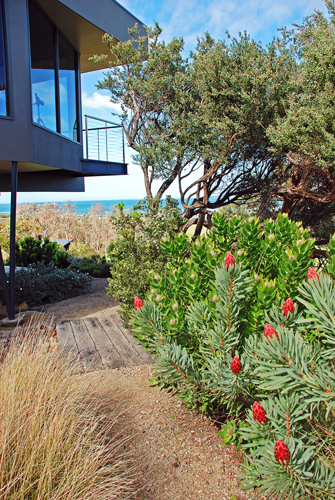Australia’s leading garden designer Jim Fogarty says coastal gardens are all about working with nature, rather than trying to fight it.
Australians have always congregated by the sea. The beach is part of our culture and lifestyle and this has influenced the way we view some of our gardens. There is also a growing trend of city workers making the lifestyle change to live by the beach, and for those fortunate enough, a holiday house is a great way to spend time off from work. Families invest a lot of time and money into creating beach lifestyles to raise their children but it is also important that as coastal areas become developed, we retain the atmosphere of the coast instead of turning the beach back into those city suburbs we are escaping.
Local clues
The best way to get inspiration for coastal gardens is to look at the coastline nearest to you. You can of course take inspiration from any coastline but the one where you are located will tell you more about the plants and colours of your area, and this is very important if you want your garden to blend into your local environment.
Look at the shapes of the coastline, how the waterline meets the sand, the colour of the sand, whether the beach has cliffs or low sand dunes, whether it is forested or scrubby grassland. Look at the colours of the plant foliage and note the main flower colours. Try to pick up on any built features whether it is a well-known landmark such as a pier or elements of interest such as a man made boardwalk.
Natural curves
The first thing you’ll notice about the shapes of the coastline is the omission of any straight lines. A coastal look is usually based around curves. Prominent curves are created by the way the water meets the sand but many other curvaceous shapes are created by wind.
Strong coastal winds will impact the way plants grow and many tall shrubs and trees become stunted in growth and tend to grow stunted and prostrate. You might also notice that plants take on a domed appearance to help keep strength from strong winds and dissipate the flow of air.
Tip: take inspiration from these shapes and think about how you can use them in your garden, whether it be the layout of paving or decking or the shapes of paths and garden beds.
Paved patches
Coastal gardens tend to avoid large areas of paving. A better aim is to make your garden appear soft and to blur the line between the natural coastal bush and your garden. If you do use paving you might only use it where you want a table and chairs but even then, it is important to use a material that blends with the environment. For instance, a beach with sandstone cliffs is conducive to using a local sandstone as a paving material. For all other areas try to keep a natural look and use a local gravel such as crushed granite or sandstone as a cost-effective and attractive path material.
Decking & timber
If you are building decks, take inspiration from piers and use wide decking boards. The wider the board width the greater the thickness it needs to prevent the boards from cupping, so make sure to use good, strong boards. Avoid rainforest timbers such as Merbau or Kwila and instead look at plantation species such as treated pine. Another great timber is Cypress which is soft underfoot and, when left untreated, will weather to a perfect grey pier look. Softer timbers like Pine and Cypress can also be stained easily.
Colour schemes
Beach colours are simple and commonly it is the colours of blue and white that will give you the beach look. Other important colours are sandstone, grey, olive, khaki, and the various shades of blue-green foliage, silver, aqua and shades of green. Try to keep your palette simple. Bright feature colours can be used effectively such as you would see in beach towels but keep this to a simple, low feature wall if you are brave, or safer still just use it for fabrics and beach towels for that final look.
Styling touches
Many coastal gardens will use flotsam and jetsam for sculptural decoration and there are many items that beach lovers can use to trigger memories of lazy days at the beach. Sculpture can play an important role in beach gardens but make sure the materials and story of the sculpture fits in with your garden theme. A beach garden should look relaxing and simple so if you aren’t sure about a piece of sculpture then don’t use it.
Plantings
Always retain indigenous vegetation and, if you are unsure, then seek professional advice and speak to your local council. Many councils will provide lists of indigenous plants, and this information is a great resource for revegetating native flora.
However, there is nothing wrong with using Australian natives from other parts of Australia as long as they will grow in the same conditions. Check your soil as some people assume coastal areas are always free draining and sandy but they can also be heavy clay and this will affect the survival of the plants you choose. Some great coastal plants include:



